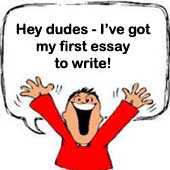Nardvark’s English teacher made him write a test, and then was cruel
enough to give him an F on it because he forgot to PEE.
When Nardvark’s teacher was explaining to the class how to
PEE, Nardvark had a nap because, as he put it, he was born peeing. Now the Nerdvark is telling him that
English teachers are talking about something completely different when they
tell you to PEE.
PEE paragraphs are used to explain your thesis, or your
answer to the question the teacher or exam asked you. Here's the lowdown on PEEing:
P is for Point: a short sentence that introduces a piece of
evidence that you will use to prove your answer. Specifically, since this is a
literary essay, which literary tool is the author/poet/playwright using?
E is for example or evidence: it can be either a quotation
(don’t forget to use quotation marks, and copy the quotation exactly as it
appears in the passage) or it can be a summary or paraphrase of a particular
part of the poem/story/play. That’s particularly useful if you are not allowed
to bring your books into the exam (AS students!!)
E is for explain: here you explain how the evidence proves
your point. Specifically, what effect does the literary tool have on the
reader/audience?
Your literary essay of course needs an introduction, which
includes the thesis or answer to the question and mentions the three points,
and should be summed up by a conclusion. You also need to state your personal response somehow – either say how the poem/play/novel made you feel, or what it
reminded you of, or whether you thought the literary tools were effective, or
compare it to another poem/play/novel you like, or compare it to a situation in
your own life, etc.
OK! So! This is the fun part: Nerdvark now makes fun of
Nardvark in an effort to show him how to apply the PEE principles, or the
principles of PEE if you will:
The poem
The Nardvark
by the Nerdvark
Nardvark has a ridiculous nose
It flops around like a rubber hose.
His ears are small and his eyes are beady,
He isn’t smart but he is greedy.
All he ever does is eat, and eat,
And eat and eat and eat and eat.
The cavernous mouth and gut - Beware!
And plus, he has terrible hair.
The question
Explore the ways in which the poet powerfully portrays a Nardvark in this poem.
The thesis
The Nerdvark powerfully portrays a Nardvark in the poem “The Nardvark” through the use of literary tools such as imagery, simile, and repetition.
Now, here’s a PEE paragraph for our first point, IMAGERY:
I’m going to do more than one example for this one. Imagery
is always a doozie.
Point: The poet uses imagery to give the reader a mental picture of what the Nardvark looks like.
Example 1: For example, his nose is "ridiculous" and it "flops;" his ears are described as "small" and his eyes as "beady."
Explanation 1: These words give the reader an image of a creature with a nose that is so long that it can't even stay straight, and silly little eyes and ears.
Example 2: The poet also uses the adjective "terrible" to describe the creature’s hair.
Explanation 2: This does not give a precise mental image, but the connotation of the word "terrible" along with the words "cavernous" and "beware" in the previous line conjure an idea of a monster. The effect of the silly face coupled with the monstrous body gives readers a picture of a fat, absurd creature.
What other points were brought up in our thesis? Try writing two more PEE paragraphs for them.
 Remember, kids, don’t forget to PEE. Here's a lovely website with more about formatting essays for exams: (click the super-excited little man)
Remember, kids, don’t forget to PEE. Here's a lovely website with more about formatting essays for exams: (click the super-excited little man)
Thanks for reading. If you enjoy my blog, please check out
my website: www.kiborrowman.net. Check
here next time for Nerdvark’s instructions to Nardvark on how to correctly use
the word “myself.” (Or he might just strangle him, because, quite frankly, all
the “myselfs” Nardvark has been inappropriately throwing around are giving
Nerdvark a nasty toothache.)

